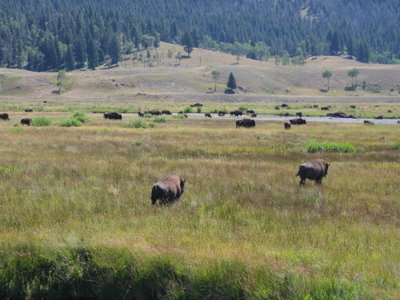Beartooth Diversion




One of the hikers we shared a campsite with in Glacier was a local from Bozeman. He recommended that, if we had time, that we make a trip to the Beartooth Mountains. We had the time, and from his descriptions it sparked our adventurous curiosity. We left Mom and Dad, who would continue exploring Yellowstone at a senior citizen pace, with plans to reunite a week later.
The Beartooth Mountains lie to the north of Yellowstone in Southern Montana. These mountains were formed from uplift during the Rocky Mountain orogeny. During the Pleistocene, glaciers scraped off the sedimentary rocks on top of the Precambrian granitic basement. Additional alpine glaciation carved cirques, valleys, horns and rock basins. Distinctive features of the area are the high plateau-type benches and steep rugged valleys, covered with hundreds of alpine lakes. The highest peak in Montana, Granite Peak (12,799’), is contained within this range.
Our first venture into the range was a 3-day backpack trip. The morning after our first night out we climbed out of the canopy of the forest to a ridge where we could see the lay of the land. The top photo is our view looking north from this high point towards the carved peaks and valleys. The second photo is a view of one of the many lakes we passed as we hiked.
After our hike, we drove the scenic Beartooth Highway. Built in 1936, it is another engineering marvel. It crosses Beartooth Pass at an elevation of 10,947’. At the pass is tundra vegetation, and spectacular views of the ranges. To our surprise there was a ski lift accessing one of the cirques. There appeared to be no base facilities, or even a road going to the bottom of the chair. We learned later that the lift does run from when the road reopens in April until July. There was nothing like a lodge at the top either – just a gravel turnout in the road. I can only imagine Montana at almost 11,000 feet during a late spring snowstorm – it was chilly enough up there in August!
We camped just outside Red Lodge, Montana in Rock Creek Canyon. Our goal was to do a day hike up Mount Rearguard (12,204’), via a trailhead accessed by a very rocky and steep former mining road. We started at the wilderness boundary, and hiked 2,500’ up to the summit. There was some question in our minds as to the actual summit location, since the top of the mountain was one of those broad plateau features. At on promontory we found an empty frosting container with a pad of paper. Inside were just a couple of entries – the register was placed at the beginning of August by a group lead by a gentleman just short of 76 years old. We judged that the actual peak was a bit to the north, so we hopped boulders to that point. The third photo is me on one of the boulders we assumed was the high point, but on closer examination of the topo map we verified the high point was at the register. Oh well, what is five or six feet. The fourth photo is the view to the east at Beartooth Mountain and Beartooth Spire, from which the mountain range derives its name.
A rest day in Red Lodge for laundry, a much-needed shower, groceries, internet, and sampling of the local microbrew completed our tour of this jewel of a mountain range.
Posted using wi-fi access from Cody Public Library, Wyoming.














